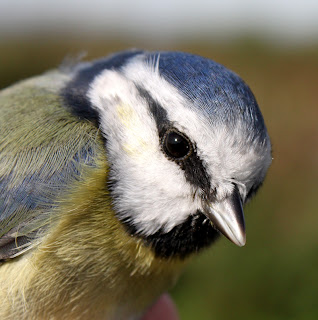The bright and breezy morning dictated a birding morning on the other patch at Pilling, a spot neglected of late, when several decent, wind-free mornings meant we could catch finches and pipits out on Rawcliffe Moss. I began at Fluke Hall looking and listening out for overhead birds but where little was happening, perhaps odd Chaffinches, Meadow Pipits, and Skylarks, but no obvious or substantial movement. If there is a morning diurnal migration taking place at Fluke it is usually quickly apparent, and in a south-easterly like today can sometimes involves a heavy movement of birds flying west to east along the sea wall.
Out on the marsh I counted over 400 Lapwing, 40+ Linnet and a Little Egret but the woodland was pretty quiet apart from a Great-spotted Woodpecker and a party of titmice. The Carrion Crows found a couple of Buzzards in the tops of the trees and they proceeded to harry the raptors until they left the woodland to head off towards the sea wall but still pursued by the persistent crows.


The walk from Lane Ends then back towards Fluke Hall began quietly, picking up as I persevered and then improving as the tide ran in. From the stile I counted 11 Little Egret, 1 Grey Heron, 1 Kestrel, 140+ Linnet, 60 Goldfinch, c2500 Pink-footed Geese, 2 Wheatear, 1 Peregrine and 2 Sparrowhawks.


The incoming tide shifted lots of pipits and Skylarks from the by now flooded marsh, and I ended up with counts of 70 Meadow Pipit and 32 Skylark, many finding their way onto the inland fields via the countless fence posts along here.

High water revealed more waders and wildfowl: 900 Shelduck, 40 Redshank, 70 Pintail, 600+ Teal, 2 Snipe, 40 Golden Plover and 35 Dunlin, with 17 Swallows also arriving with the tide and then heading quickly south-east.

On the subject of Swallows, we have only just heard of a Swallow recovered during the early part of 2010. Ring number V971589 was first captured on Rawcliffe Moss as a juvenile bird of the year on 8th August 2009. On April 27th 2010 the Swallow, now sexed as a female by the length of its tail streamers, was caught by other ringers in Canton Magistris, in the Alpine region of Italy; the young bird had managed to journey to Africa and was now on its way back to the UK.
While British Swallows migrate to and from Africa through the area of the Mediterranean Sea in both autumn and spring, many take a more easterly route for the April/May journey, a direction which can take some through the Alpine regions of Italy. The interval between ringing and finding in Italy was 262 days and the distance involved 1198 kms.

There looks to be more breezy days ahead but amazingly it’s almost a shirt sleeves Indian Summer for a few days more.



























































.jpg)












